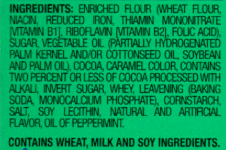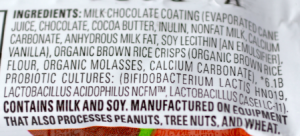The Got Milk Campaign
Developed for the California Milk Processor Board in 1993, Got Milk? was a campaign to help sell more milk. It was apparently successful in California but not so much in the rest of the country. It was a cute campaign with a lot of celebrities painted in milk mustaches among other visuals. It appeared both as magazine ads and television commercials.
Allergic to dairy?
The concept of “got milk?” takes on a different connotation when you can't have milk or dairy products. Similar to those who can't have gluten and have significant health problems when they get “glutened,” for those who are sensitive to dairy or any of its parts consumption can be very dangerous.
Lactose intolerance
There are different issues related to consuming dairy products. One is Lactose intolerance. This is where the body does not produce enough of a particular digestive enzyme, lactase, to break down the lactose (milk sugar). Most people lose their ability to produce lactose in early childhood. That leaves a lot of people who struggle with the symptoms of lactose intolerance when they eat yogurt, milk, cheese, ice cream, or any other dairy product. Symptoms can include
- bloating
- diarrhea
- farting
- gas
- stomach cramping or upset
Milk protein allergy
Another issue with dairy consumption is the protein in the milk. There are two different types of protein, whey and casein. Whey is made by removing the milk protein solids. It's often found in protein beverages or athletic recovery formulas and may be listed as either whey protein, whey protein concentrate, or whey protein isolate. Whey is rapidly absorbed into the system. Depending on how lactose intolerant you are, when consuming whey you may also have lactose intolerance issues going on as there is a small amount of lactose in whey.
The other protein, casein, is also sometimes found in protein beverages. The body responds more slowly to casein and because of this slower breakdown tends to promote fullness longer. Some people are allergic to either casein or whey, some people are allergic to both.
Some of the symptoms of lactose intolerance and milk protein allergy are the same. However, over time the milk protein allergy can worsen. For those who are allergic to whey or casein, it can even be fatal. Because these allergies can pose significant health problems it is important to work with an allergist for testing and support if you suspect there is a problem. Allergy symptoms include:
- Abdominal cramps
- Anaphylaxis
- Behavioral health changes
- Bloating
- Diarrhea
- Fatigue
- Hives or rash
- Joint Pain
- Wheezing or difficulty breathing
Know your dairy ingredients
It's important to note that just because a product is labeled lactose free that does not mean that it is dairy-free. When there's an allergy it is a matter of concern about whether or not there is dairy in what you are eating. On packaged food labels there are a lot of ingredients to watch out for that are derived from milk. If there is a lactose intolerance or a milk protein allergy, these need to be avoided:
- milk
- butter
- casein
- casinate
- cheese
- cream
- curds
- whey
- lactalbumin
- lactoferrin
- lactose
- lactulose
- yogurt
Surprising places for dairy
In addition to these ingredients, there are a number of surprising items that are derived from dairy or that may contain dairy. It's not always clear and you may not be aware of what to watch out for:
- artificial sweeteners
- baked goods (many of these are unlabeled)
- bath products
- breath mints
- candy
- canned tuna fish (may contain hydrolyzed caseinate)
- caramel
- chewing gum (may contain milk protein)
- medications (if this is a concern talk with your pharmacist)
- hot dogs
- lunch meat (cross-contamination may also be an issue)
- margarine (while these are not butter, they may not be dairy-free)
- potato chips
- soy cheese (some of them still include dairy)
- spice mixes (may contain whey powder)
- whipped topping (these are marketed as “non-dairy” but often contain casein)
Food allergy labeling
While that's a lot to keep track of, for those who have a significant, life-threatening allergy to dairy it is critical that they are aware of what's in what they are eating. Because dairy is one of the seven top allergens in this country it does need to appear on the label as an allergy statement like the example below where the allergens are listed in bold

Another labeling example is when foods do not necessarily have dairy (or other top food allergen) products in them but are made in a facility that also processes a food allergen such as the example below. This statement is also in bold type.

Eating away from home
While labeling might show if there's dairy in packaged foods, this all goes out the window when eating out at a restaurant or at someone else's home.
It is possible to ask if there's dairy in a product and be told no but to discover that it's finished with butter. Or to have someone not be aware of what's in a dish.
Even for those who are not allergic but have a food intolerance or delayed hypersensitivity, accidental exposure may cause a heightened reaction as the body reacts more strongly to the substance it's trying to clear.
For those with life-threatening allergies to dairy any exposure poses a dangerous situation. Be aware of your setting and the possibility of exposure. It's important to ask if your food allergen is in the meal that you are being served. It can also be helpful to use a Food Allergy Buddy Card (available for free download).


I agree, milk is everywhere! One thing that a lot of people do not understand is that allergy statements are completely voluntary. If a food product contains one of the top 8 allergens, it must be listed as an ingredient but it does not have to be called out in a separate allergy statement. This is why it is so important to read the entire ingredient label.
I stopped drinking milk in college because it was making me sick. Lucky for me, my reaction is not life-threatening. I knew about SOME of these items but certainly not ALL of them! Phew! XO
Katherine.
SInce we started to follow an eating lifestyle
called Whole 30 – I had no idea how serious
this all was, thank you for sharing this valuable information.
If you’re sensitive to gluten/grains … you could be sensitive to dairy too. http://t.co/UhoUoz9nMQ
I seem to do ok with dairy thank goodness but understand this issue as I cannot tolerate gluten
This is an extemely helpful list of ingredients I’m sure many people are not even aware of.
My clients are not eating processed foods or margarine and such but I’m sure they like to know that even some of the real food products like spice mixes may contain something like whey powder. I certainly was not aware of this. I’ll be sharing this blog with my community – thanks!
Thx! RT @RomanticComedyG: got milk? – http://t.co/RZahKkNgQV via @MiraDessy If you have a dairy intolerance or allergy this is a MUST READ!
got milk? – http://t.co/aD7r3MLiKY via @MiraDessy If you have a dairy intolerance or allergy this is a MUST READ!
got milk? – http://t.co/aD7r3MLiKY via @MiraDessy If you have a dairy intolerance or allergy this is a MUST READ!
I know someone who has to cut out dairy and will share this with her. Perfect timing. At least it’s not life threatening for her. You’ve pointed out how aware and vigilant you must be when it is, because it hides in so many places.
Wow. I had no idea just how prevalent dairy was; including processing plants where dairy is… http://t.co/kB2JyJwuPR
Wow. I had no idea just how prevalent dairy was; including processing plants where dairy is made/used. I wouldn’t have thought of this. Such great information. Thanks!
got milk? – http://t.co/PDuwALWN5l via @shareaholic
Thanks for sharing this info. I don’t have this issue but for those who do, knowing the labeling is critical.
RT @MarketingMel: Got milk? Good information for those with dairy allergies. via @MiraDessy http://t.co/F3deReAueW
Fascinating to read just how much dairy is in and all the names it goes by – I am dairy intolerant rather than allergic so a small amount is ok. even reading labels I had no idea it was in breath mints! Thanks for the eye opener
Wow Mira. I had no idea there was so much dairy everywhere! Thank you for informing us. I know I do better without dairy or sugar.